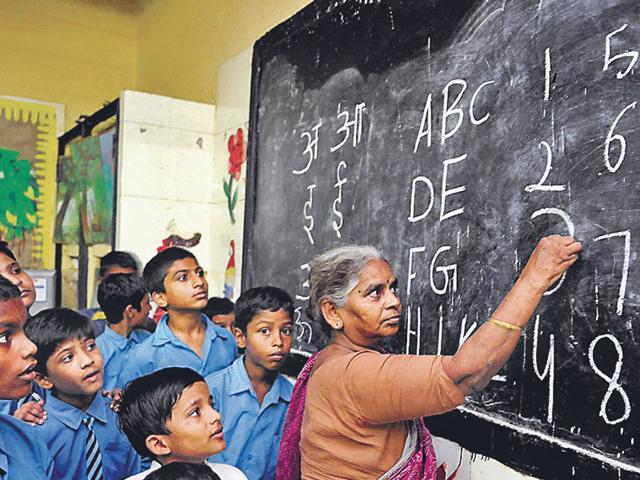NDA’s penchant for acronyms won't lead to development
The NDA’s penchant for acronyms and slogans will not lead to development or improve people’s quality of life, writes Jyotiraditya Scindia.
Later this year, world leaders will converge to determine a new development agenda post the Millennium Development Goals (MDGs) that were set to be realised by 2015. India — with its 1.2 billion people — has an important role to play in both determining and realising this new set of goals.

While we have succeeded in achieving several of the MDGs — in large part, due to the UPA’s unwavering commitment since 2004, to aiding the marginalised using a rights-based approach — challenges remain. Over 20% of the population remains below the poverty line, and issues such as gender inequality, women’s security, infant mortality, and absence of primary healthcare and sanitation facilities persist.
Each of these challenges require a serious and concerted policy response. Unfortunately, however, the NDA’s performance in the area of social development this past year has been dismal.
A year ago, Prime Minister Narendra Modi took office after making grand promises to address gender disparities, create jobs, remove poverty, and solve education and health problems. But during its first year, his government has repeatedly demonstrated a lack of seriousness in meeting these promises, cutting funding to social sector programmes by Rs 4,39,192.25 crore.
These cuts are across all social sector ministries and plans — healthcare, education, women and child development, drinking water and sanitation, rural development, agriculture, the MNREGA, and the Mid-Day Meal scheme. These cuts have also adversely affected several of the UPA’s signature schemes, which were critical to allowing India to be successful in achieving several MDGs — reducing poverty by half, achieving nearly-universal primary school enrolment, reducing hunger by half, and combating the spread of several deadly diseases.
One of the biggest successes of the UPA had been the vast increase in school enrolments, stemming from the flagship Right to Education Act. But under the Modi government, the allocation for the Sarva Shiksha Abhiyan has been reduced by nearly 80%. There have been similar cuts in allocations for both secondary and higher education.
Without adequate education, the MDGs on achieving universal primary education and empowering women through reducing gender disparity across all levels of education have no leg to stand on. In fact, it is hard to take the government’s own programmes — such as Make in India or Skilling India — seriously if it fails to demonstrate a commitment to addressing core education challenges.
In its manifesto, the BJP promised several initiatives for the development, protection, and security of women. Unfortunately, its track record in this area has been abysmal. Not only has the government failed to develop a coordinated approach to address the wide range of challenges related to gender equality, the women and child development ministry has also witnessed one of the largest reductions in allocations.
The UPA’s efforts led to a significant reduction in the number of women dying during childbirth thanks the innumerable schemes launched over the past 10 years. The funding for all of these programmes has been adversely affected by the cutback.
The reduced funding has had severe repercussions for the Integrated Child Development Scheme (ICDS) and the National Rural Health Mission. For instance, the ICDS — one of the world’s largest social programmes — was instrumental in revolutionising the primary healthcare system, specifically targeting care for pregnant and lactating mothers as well as supplementary nutrition, immunisation, health check-ups and referral schemes. But now, with the new ICDS allocation, there is hardly any funS to even pay anganwadi workers.
The cuts in the budget of the ICDS also point to a larger neglect of the healthcare needs of the country. Several programmes face an uncertain future, especially as the plan outlays for the National Health Mission have been reduced by 20%. Far from realising the BJP’s electoral promise of universal health coverage, this pushes India back.
Unfortunately, the move by the Centre to devolve more funds to states has backfired. As a consequence of this policy, states are now able to allocate funds according to their own needs, and no funds are tied to specific social sector priorities determined by the Centre. While this gives states greater autonomy, it also means that they may choose to discontinue some of the most important schemes that were earlier sponsored by the Centre due to the lack of funds.
In addition, poorer states that depended on the Centre’s assistance will now face losses. Research finds that in such scenarios states — particularly the poorest ones — are most likely to reduce their expenditure in areas such as healthcare and sanitation. While states implement programmes, the Centre has an important role to play in outlining the key priorities for the country — unfortunately, under the guise of giving states greater autonomy, the Modi government has abdicated its own responsibility in guiding and facilitating social development.
The Planning Commission offered mechanisms to work with states, but the Modi government has also dispensed with this critical institution. As for the much publicised Niti Aayog, its implementation remains lackadaisical, and we still don’t know what its role in the policy planning and implementation process will be.
Alas, this is like most of this government’s policy pronouncements — if only catchy acronyms and slogans also led to grassroot-level implementation and development. But unfortunately, development cannot be generated in the media, and unless concrete measures are taken, social transformation will remain but a distant dream. Perhaps the next Guinness record the government might want to accomplish is an improvement in the quality of its people’s day-to-day lives.
(Jyotiraditya Scindia is a Member of Parliament. The views expressed are personal.)





